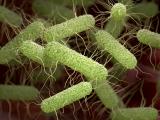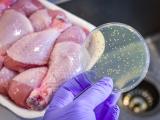Jul 9, 2010 (CIDRAP News) – New federal rules designed to reduce Salmonella Enteritidis (SE) contamination in eggs from large-scale producers take effect today, with the Food and Drug Administration (FDA) predicting that they will prevent up to 79,000 illnesses per year.
The rules, several years in preparation, require producers to adopt a number of preventive measures, including refrigeration during transportation and storage. They cover operations with more than 50,000 laying hens, a group that accounts for about 80% of US egg production, the FDA said in a statement.
Producers who have fewer than 50,000 but more than 3,000 laying hens and whose eggs are not pasteurized or otherwise treated to reduce pathogens will be subject to the safety rules in 2 years, the FDA said. Producers who have fewer than 3,000 layers or sell all their eggs directly to consumers are exempt from the regulations.
If laying hens are infected with SE, the pathogen can be found inside their eggs, which appear normal, the FDA noted.
The agency predicted that the new preventive measures will reduce the number of SE infections from eggs by nearly 60% and prevent up to 30 deaths per year.
Under the new rule, the FDA said, large producers who don't use a treatment such as pasteurization must:
- Buy chicks and hens only from suppliers who monitor their birds for Salmonella
- Establish rodent- and pest-control measures and biosecurity measures to prevent people and equipment from spreading bacteria
- Test for SE in their poultry houses and, if it is found, follow up with biweekly testing of eggs for 8 weeks. If any of the tests are positive, the eggs must be further processed to destroy bacteria or diverted to nonfood use.
- Clean and disinfect poultry houses that test positive for SE
- Refrigerate eggs at 45ºF during storage and transportation, starting no later than 36 hours after they are laid. This requirement also applies to producers who use pasteurization and to those who transport or hold eggs.
In addition, producers must have a written SE prevention plan and keep records of their compliance with the regulations, the FDA said.
The FDA and the US Department of Agriculture began moving to control SE in eggs in the 1990s, today's announcement noted. The agencies used measures such as refrigeration requirements to control the growth of bacteria in eggs, but these did not prevent the initial contamination.
The original version of the new regulations was proposed in 2004. The FDA announced the final rule a year ago, giving large producers a year to prepare and smaller producers 3 years. At that time, officials said the biggest change probably would be the refrigeration requirement, since producers previously were not required to chill eggs until they were packaged for consumers.
Craig Hedberg, PhD, a foodborne disease expert at the University of Minnesota in Minneapolis, said the new regulations should lead to a significant reduction in salmonellosis cases but cautioned that eggs are not the leading source of Salmonella infections.
"There are probably 1.2 to 1.4 million cases of Salmonella infection that occur each year in the US," he commented by e-mail. "Thus, while reducing the burden by 79,000 is significant, it won't result in a major overall reduction in Salmonella. There are many sources for Salmonella, and eggs are not the primary source."
Hedberg said internal contamination of eggs by SE first surfaced in the 1980s and resulted in Salmonella outbreaks all over the world.
"Because there are specific strategies for preventing this particular transmission route, it is important to do so. Many of the other sources of Salmonella are not so well defined, thus not so readily prevented," he said.
He also noted that there are other Salmonella serotypes that can be transmitted by eggs, and the new regulations could reduce some of the illness burden caused by them. At the same time, not all SE cases are related to eggs, so better safety rules for eggs will not eliminate SE, he added.
"I think the rules are reasonable, but I don't think that you can treat uncooked shell eggs as ready-to-eat foods," Hedberg said. "There will always be a residual risk of contamination."
The FDA evidenced a similar view in its announcement, saying consumers should continue to cook eggs and foods containing eggs thoroughly.
In other developments today, the US Department of Health and Human Services and USDA issued a statement claiming significant progress on the food safety front since President Obama's Food Safety Working Group released a set of findings and recommendations a year ago.
The statement lists a number of steps the federal agencies have taken in the past year to enhance prevention of food safety problems, strengthen inspection and enforcement, and improve the response to foodborne disease outbreaks and contamination incidents.
See also:
Jul 9 FDA announcement
http://www.fda.gov/NewsEvents/Newsroom/PressAnnouncements/ucm218461.htm
July 7, 2009, CIDRAP News story "Officials release food safety plan, egg safety rules"
http://www.cidrap.umn.edu/cidrap/content/fs/food-disease/news/jul0709foodsafety.html
Sep 22, 2004, CIDRAP News story "FDA proposes rules to reduce Salmonella in eggs"
http://www.cidrap.umn.edu/cidrap/content/fs/food-disease/news/sep2104eggs.html
Jul 9 HHS-USDA statement on food safety steps of past year
http://www.hhs.gov/news/press/2010pres/07/20100709a.html
















